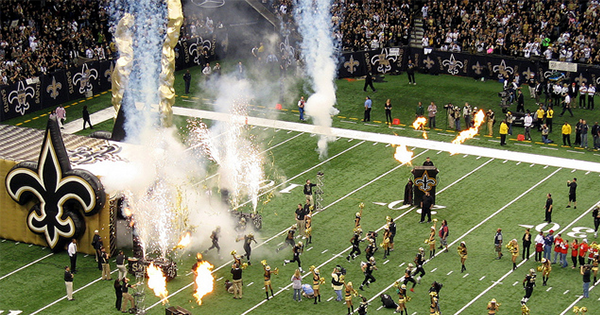
The New Orleans Saints kick off the 2015 NFL season tonight with a preseason game against Baltimore. And so from now until the end of the year, possibly longer, the mood of the city will be tightly hitched to the rise and fall of its home team.
I’ve never lived anywhere that was as irrevocably entangled with a sports team as the city of New Orleans. This enthusiasm does not parse by socioeconomic status or age or race. Everybody becomes badly infected over time, with the possible exception of newly arrived hipsters who define themselves chiefly by what they reject. Even so, those who consider themselves immunized often display symptoms.
I experienced this when my wife and I moved here from New England a year after Hurricane Katrina. When we arrived, my wife was the opposite of a football fan. She actively disliked football and the monster-men who played it and the Bud Light-swilling people who watched it.
But shortly after we arrived, as the Saints began their run at the 2006 playoffs, pictures started cropping up on Facebook and elsewhere of her in her Marques Coulston jersey and cheering wildly in bars, often in the company of similarly dressed people. Throughout the games she was always voluble and enthusiastic, if still a little unclear about the difference between a field goal and a punt. Her siblings began to email me and ask if everything was okay.
It was hard to explain. You had to be here.
Much has been written about the rise of the Saints in the immediate post-Katrina years—they made the playoffs in 2006, and won the Super Bowl in 2009. You’ve no doubt read about how the games were an excuse for the city to take a break from the laborious effort of rebuilding itself and to join together. And how the often beleaguered Saints came to represent the city itself—rising above the its tattered past and the dim expectations of outsiders. It didn’t hurt that so many of the key players, like quarterback Drew Brees and running back Deuce McAllister, inserted themselves into the community to help with the rebuilding. That so many of us saw Brees at the uptown Whole Foods picking up groceries, or playing with his kids at Audubon Park, did much to erase the notion of arrogant millionaire athletes living behind moats.
But it was far more than that. This is a city built on a call-and-response approach to just about everything. The line between entertainer and audience is often fuzzy. Taking an out-of-town visitor to a second line parade invariably requires an explanation that one doesn’t watch the parade; one is the parade. The band provides the soundtrack; the social aid and pleasure club members provide the color; the audience provides the spectacle.
This also happens in clubs where the local brass bands play regularly—the audience is almost always the uncredited extra instrument, and the best musicians know how to work it. Among the maestros is the talented trombonist and vocalist Glen David Andrews, who grew up in Tremé, and has regular gigs in bars around town. He plays the audience as if it were an extension of his trombone. “Everybody scream,” is not just what the announcer says through the speakers at the Superdome; you hear it in bars all around town, every night, shouted out from the stage every three minutes or so.
During the big, nationally televised football games leading up to the championship, television cameras would often cut away from the game to a static shot of Bourbon Street from a second-floor balcony. It looked exactly as it did during the Sugar Bowl or a cardiologist convention—people milling about with drinks in hand. This would be accompanied by anodyne comments from announcers about “the big party in a city that knows how to party,” or “crazy New Orleanians looking for any excuse to get crazy.” As Richard Sandomir of The New York Times put it at the time, “reaction shots of postgame celebrations of other cities are almost irrelevant, but to give New Orleans such shabby treatment was surprising.”
What television never captured—nor could it capture—was how the success of the public Saints was also the private success of the city. When the Saints won an essential game, I’d walk out of our house and stand in the street and listen to wave after wave of celebration extending into the distance.
The Saints said, “Everybody scream!” and the city screamed. It was the extension of a long-familiar ritual, and the sound of a city rising up and returning to normal.

